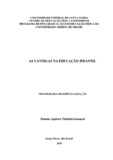| dc.contributor.advisor | Temp, Haury | |
| dc.creator | Somacal, Simone Aguirre Timbola | |
| dc.date.accessioned | 2019-03-12T12:25:40Z | |
| dc.date.available | 2019-03-12T12:25:40Z | |
| dc.date.issued | 2015-02-20 | |
| dc.date.submitted | 2015 | |
| dc.identifier.uri | http://repositorio.ufsm.br/handle/1/15873 | |
| dc.description | Monografia (especialização) - Universidade Federal de Santa Maria, Centro de Educação Física e Desportos, Curso de Especialização em Educação Física Infantil e Anos Iniciais, EaD, RS, 2015. | por |
| dc.description.abstract | This work was developed from a qualitative exploratory research aiming to present the different songs used in kindergarten, their goals, objectives and importance on the school day. The methodology used was arrested classroom observation and the use of a questionnaire is that the classes were chosen for Maternal I with children aged 2 years and I Garden with children 5 years of age. The choice of schools was random and there was authorization of the directors of the same to the research. It was noticed that the use of songs by the participating teachers in the study of both groups, not only has the function of only brighten and calm the students, taking an important role in the teaching-learning process of students improving their skills, thereby promoting a development motor, cognitive and affective significant through play. This feature is used by audiovisual such as television, radio, CD, DVD, but mainly for the most common and enjoyable way to students, sung by the teachers themselves and going at different times during the lesson. The lyrics of the songs are mostly well understood by students, taking into account the age of each group and which activities are used because the teachers make much use of this feature, especially for activities related to physical education, because according to opinion of them, it stimulates attention, speech, respect among students, body language, socialization, vocabulary expansion, motor and many others, thus promoting the integral development of children. | eng |
| dc.language | por | por |
| dc.publisher | Universidade Federal de Santa Maria | por |
| dc.rights | Acesso Aberto | por |
| dc.rights | Attribution-NonCommercial-NoDerivatives 4.0 International | * |
| dc.rights.uri | http://creativecommons.org/licenses/by-nc-nd/4.0/ | * |
| dc.subject | Educação infantil | por |
| dc.subject | Cantigas | por |
| dc.subject | Benefícios | por |
| dc.subject | Early childhood education | eng |
| dc.subject | Songs | eng |
| dc.subject | Benefits | eng |
| dc.title | As cantigas na educação infantil | por |
| dc.title.alternative | The songs in early childhood education | eng |
| dc.type | Trabalho de Conclusão de Curso de Especialização | por |
| dc.degree.local | Polo de Serafina Corrêa, RS, Brasil | por |
| dc.degree.specialization | Educação Física Infantil e Anos Iniciais, EaD | por |
| dc.description.resumo | This work was developed from a qualitative exploratory research aiming to present the different songs used in kindergarten, their goals, objectives and importance on the school day. The methodology used was arrested classroom observation and the use of a questionnaire is that the classes were chosen for Maternal I with children aged 2 years and I Garden with children 5 years of age. The choice of schools was random and there was authorization of the directors of the same to the research. It was noticed that the use of songs by the participating teachers in the study of both groups, not only has the function of only brighten and calm the students, taking an important role in the teaching-learning process of students improving their skills, thereby promoting a development motor, cognitive and affective significant through play. This feature is used by audiovisual such as television, radio, CD, DVD, but mainly for the most common and enjoyable way to students, sung by the teachers themselves and going at different times during the lesson. The lyrics of the songs are mostly well understood by students, taking into account the age of each group and which activities are used because the teachers make much use of this feature, especially for activities related to physical education, because according to opinion of them, it stimulates attention, speech, respect among students, body language, socialization, vocabulary expansion, motor and many others, thus promoting the integral development of children. | por |
| dc.publisher.country | Brasil | por |
| dc.publisher.initials | UFSM | por |
| dc.subject.cnpq | CNPQ::CIENCIAS DA SAUDE::EDUCACAO FISICA | por |
| dc.publisher.unidade | Centro de Educação Física e Desportos | por |



